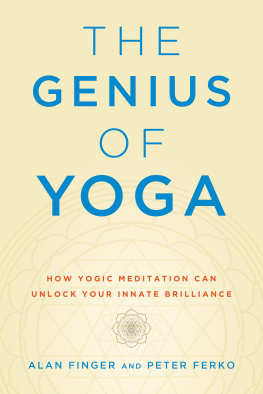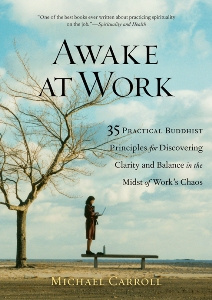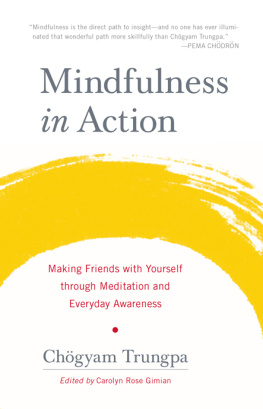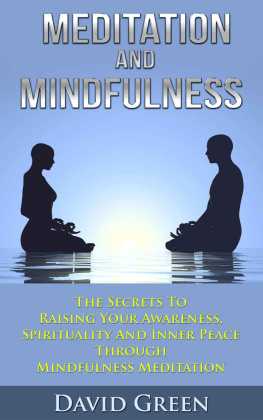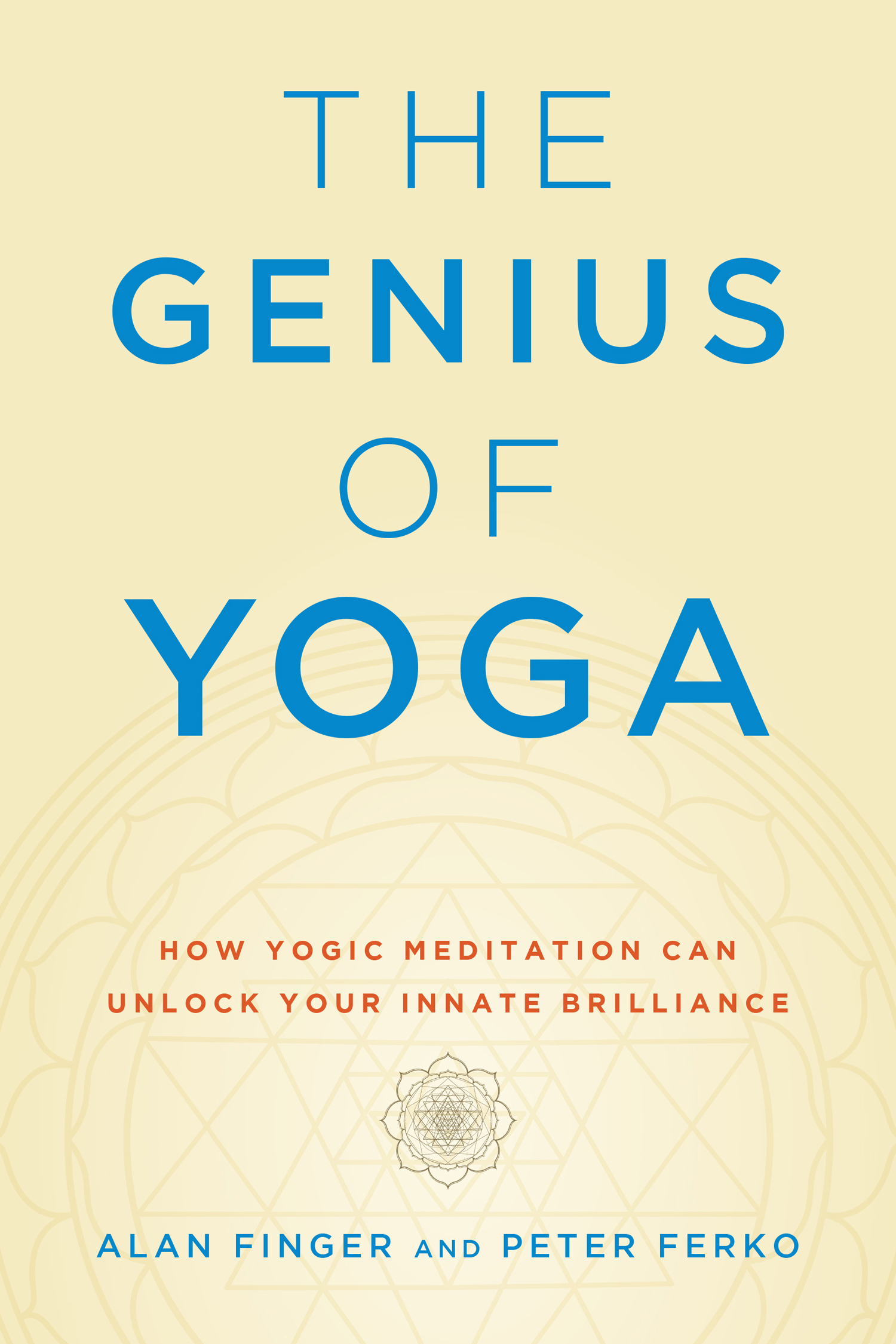Shambhala Publications, Inc.
All rights reserved. No part of this book may be reproduced in any form or by any means, electronic or mechanical, including photocopying, recording, or by any information storage and retrieval system, without permission in writing from the publisher.
Names: Finger, Alan, 1946 author. | Ferko, Peter, author.
Title: The genius of yoga: how yogic meditation can unlock your innate brilliance / Alan Finger and Peter Ferko.
Description: First edition. | Boulder, Colorado: Shambhala, [2020] |
Includes bibliographical references and index.
Subjects: LCSH : Yoga. | Meditation. | Mindfulness (Psychology)
Classification: LCC B132.Y6 F559 2020 | DDC 181/.45dc23 LC record available at https://lccn.loc.gov/2019042343
Introduction
You Can Access Your Genius
Y OGA PRACTITIONERS have been using meditation practices for millennia. These practices have evolved as tools for improving health, healing emotional imbalance, and connecting with ones purpose and direction in life. Meditation provides a transcendence of ordinary mental activity into the realm of what is spiritually described as connecting you with pure consciousness. In colloquial terms it could be called finding your genius, the aspect of yourself that is full of intuition and creativity, insight and purpose, and an innate brilliance. Yogis consider it finding the whole of who you are.
Mindfulness practices that are sweeping the world often begin the process but remain embroiled in ones ordinary mental activity. As yogis, we see this as an unfortunate place to stop meditation training. In this book we look at the important benefits of taking meditation beyond mindfulness. Using contemporary language, we aim to demystify the traditional descriptions and practice of yoga meditation.
The medical profession has limited its research to date on practices that are easiest to test, such as mindfulness-based stress reduction. We make the case that the rich traditions of teaching yoga meditation and observing the inspiration and wisdom that result are equally valid justifications for learning these practices, even though researchers dont know how to test them.
This book provides background and a starting practice that is suited to anyone, from the curious nonmeditator to the seasoned mindfulness practitioner. It is a call to the genius waiting within.
A Note about Sanskrit in this Book
Sanskrit is a language that has been used by practitioners of meditation for millennia. It isnt just a foreign language, or a dead language; its actually a language that is made for describing and working with meditation, mental states, energy, and practices related to these things. Like the jargon that professionals use in their fields, Sanskrit has words that are specific to the topic, and translating them into ordinary language often leaves us a bit confused. One Sanskrit word can stand for a complex idea that might require paragraphs to fully clarify in English. Once a practitioner understands the Sanskrit word, he or she can draw connections and understand meditation more easily.
Sanskrits unique character also extends to its structure. Sanskrit letters and words are designed as much for how they vibrate as for what they mean, making Sanskrit similar to music. Yogis have found that sound vibrations alter ones consciousness. You can see how music does this. Different kinds of music affect us so differently. Strong beats make us move and can even make us aroused or aggressive. Classical music or jazz sometimes create more subtle emotions. Indian music is designed to bring about a range of effects from creating emotions to uplifting the spirit. Because of the unique vibratory quality of Sanskrit, Sanskrit words are sometimes used as part of a meditation technique.
Our goal in this book is to provide an introduction to the whole of meditation, and we think getting a little understanding of Sanskrit will help clarify what people are talking about when they use the English words mindfulness and meditation. Well share why there is value in some use of Sanskrit and in understanding certain words as carriers of vibratory energy rather than simply seeing them as antique or religious ideas. That way you can test for yourself, instead of getting a version of meditation that is sanitized for westerners just on principle.
Mindfulness and Beyond
F OR THE PAST FEW DECADES , the popular press has been reporting on a kind of meditation practice called mindfulness. This name is actually shorthand for a protocol that was designed by researchers in the 1970s and is very specifically defined so those researchers can collect data. For thousands of years before that, yogis had been practicing meditation using a variety of techniques based on the teacher, the student, and the culture of the time. The goal of this yoga meditation is to find ones whole self, to move past the mundane mental activity to experience consciousness itself. It does not lend itself as easily to todays Western data collection methods because of the many variables involved, but practitioners have experienced the benefit of yoga meditation practice and express it using descriptors like bliss, self-realization, purpose, oneness, love, and unbound potential. In this book, were calling it genius.
This idea of genius emerged from an experience Alan had as a teenager. He had started yoga and meditation practice under the guidance of his father, who was a yoga teacher. Alans initial practice was intensive. His father would wake him at 4:30 in the morning and guide him through a three-hour practice. After three months, Alan started to experience a transformational state during meditation, where his mind was not present in the ordinary way, and his consciousness would expand. One morning, after this experience, he opened his eyes to see if his father had finished his own meditation. The sun had risen and was shining through a lace curtain and was falling on his father. It was a magical moment. Alan closed his eyes to meditate a little longer, and he clearly saw the image of his father with the sunlight. Alan realized, thats how film works. He saw in his mind how light landed on film, and chemicals reacted to light. He realized the process of reversing the image by printing from a negative onto paper.
Up to this moment, Alan had never touched a camera or even thought about photography. When his father had finished meditating, Alan told him that he had worked out how film and photography worked. His father gave him a puzzled look, but then he realized what had happened. He said to Alan, I told you how everything in the universe is already there in the etheric patterns, and what humans do is unfold it in the process of evolution. Ones ordinary mind cant tap into this knowledge, but when the mind is quiet and becomes still, it accesses this source of what we call genius. Inspiration and understanding flow from there. To further demonstrate the point, Alans father took him to a local camera store and bought him a camera and darkroom equipment. As soon as he set up everything, Alan just knew what to do. The whole process excited him and within a month he was doing the complex work of chemical-based color photographic shooting, processing, and printing. All without any further instruction.

